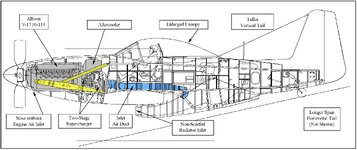BarnOwlLover
Staff Sergeant
I know that the XP-51J (the Allison powered lightweight Mustang) had the supercharger intake relocated from the nose to the radiator ducting. I've wondered how this tract worked, and, one, if it was a possible source of power getting robbed (due to the snaking intake instead of a direct shot to the supercharger/carb), and two, if it negatively impacted airflow to the radiator.
I was also reading the Michael O'Leary Building the P-51 Mustang book last night I just got and there was a XP-51B pictured with no apparent supercharger intake under the nose. It was suspected in the caption that it may've been located in the radiator intake like on the XP-51J.
I was also reading the Michael O'Leary Building the P-51 Mustang book last night I just got and there was a XP-51B pictured with no apparent supercharger intake under the nose. It was suspected in the caption that it may've been located in the radiator intake like on the XP-51J.

